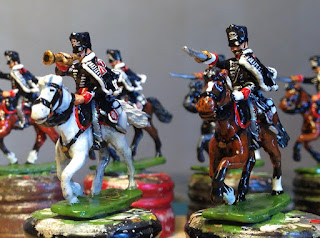Readers of this blog may have noticed a tendency to flit from cavalry regiment to cavalry regiment without completing anything. I think this was partly because it allowed me to put off an an important decision, which was whether or not to have a go at doing any command figure conversions!
Pictured are my first two attempts, being an officer and a trumpeter of the 2nd Leib Hussars.
 The officer was very simple, requiring no more than the removal of his carbine and a slightly different colour scheme.
The officer was very simple, requiring no more than the removal of his carbine and a slightly different colour scheme.
The trumpeter, on the other hand, was a little trickier as the trumpet is constructed entirely out of solder using a technique known as "stringing". It was the noted Hinton Hunt collector and converter, Steve C, who told me how to do this. Steve's own words tell it best, so here they are:
"I use a 30 watt ANTEX iron with a taper tip. It took me years to get it right but I find the best way is to melt a non-fluxed plumbers solder wire onto the tip and let it build onto the tip until it's almost dripping off . This I think is the critical part.
Clean the figure to be repaired by filing and leaving a bright alloy surface, then gently touch the drop of solder onto the piece to be rebuilt, then 'tease' the iron gently away as the solder stretches. As soon as you have the required length of solder, press the joint into a wet sponge to quench it and it will harden the lead alloy straight away ready for filing to shape .
If you try to be too fast the solder just pulls away, if you try to be too slow you burn the figure away".
Steve's advice also woke me up to the fact that soldering iron wattage is actually quite important. Higher powered soldering irons are probably much too hot for work of this kind!
WM
Pictured are my first two attempts, being an officer and a trumpeter of the 2nd Leib Hussars.
 The officer was very simple, requiring no more than the removal of his carbine and a slightly different colour scheme.
The officer was very simple, requiring no more than the removal of his carbine and a slightly different colour scheme.The trumpeter, on the other hand, was a little trickier as the trumpet is constructed entirely out of solder using a technique known as "stringing". It was the noted Hinton Hunt collector and converter, Steve C, who told me how to do this. Steve's own words tell it best, so here they are:
"I use a 30 watt ANTEX iron with a taper tip. It took me years to get it right but I find the best way is to melt a non-fluxed plumbers solder wire onto the tip and let it build onto the tip until it's almost dripping off . This I think is the critical part.
Clean the figure to be repaired by filing and leaving a bright alloy surface, then gently touch the drop of solder onto the piece to be rebuilt, then 'tease' the iron gently away as the solder stretches. As soon as you have the required length of solder, press the joint into a wet sponge to quench it and it will harden the lead alloy straight away ready for filing to shape .
If you try to be too fast the solder just pulls away, if you try to be too slow you burn the figure away".
Steve's advice also woke me up to the fact that soldering iron wattage is actually quite important. Higher powered soldering irons are probably much too hot for work of this kind!
WM

Dynamic and splendid!
ReplyDeleteCheers Phil!
DeleteI am awed!! Does it enable you to create the curled tube of the trumpet?
DeleteAs it is looks lovely.
Cheers, Roy. If you think that's good you should see Steve's lances!
DeleteThe trumpet end was made by "stringing" onto a steel ruler, which acted as a heat sink that wouldn't stick to the solder. This produced the cone shape, which I then filed to accentuate the curled edges. Far trickier was then brazing it to the hand. The mouthpiece was made by "stringing" straight onto the other side of the hand. I retained a bit of the sword guard to create at least a suggestion of trumpet tubing.
Great figures and excellent how-to section - an epic post, sir, if I may say so. Now I may have to have a go at the soldering again - see what you've done.
ReplyDeleteThank you, Foy. Not posted are the half dozen figures that I turned into molten puddles before I got to this stage. Good luck!
DeleteGood work with that soldering iron - have thought of getting one myself , Tony
ReplyDeleteThanks Tony. Get the lowest-powered one that you can!
DeleteWe both seem to be in bugle mode at the moment - yours looks fantastic... you won't want to see mine!
ReplyDeleteSo we are! I blame that Roy too.
DeleteFor trumpet ends, see my reply to Roy above, which is my own invention!
Excellent work, would be nice to see your Prussians together en masse
ReplyDeletePaul
Thanks Paul. A Prussian "Grand Review" should not be too far off, I hope! I should really get the Garde du Corps finished first, however....
DeleteI'm painting a HH Russian Corps and need some dragoons, has anyone converted a Chevalier Guard or similar figure. If I can get hold of some suitable figures
DeleteI aim to convert and cast them
Hi ScattiAtti. I've no Russians of any description, I'm sorry to say. Have you got a contact address for anyone who may be able to help you out?
Delete